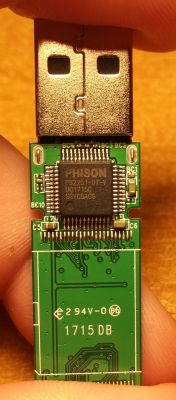FAQ
TL;DR: NAND wear is the culprit: erase/write uses ~20 V and "the service life of new circuits is much lower." You can reflash a failing Verbatim 32 GB, but treat it as disposable after recovery. [Elektroda, kaleron, post #18053706]
Why it matters: This FAQ helps Verbatim Store 'n' Go 32 GB owners revive an unresponsive PS2251‑07 stick using Phison tools, while setting realistic reliability expectations.
Quick Facts
- Controller reported: Phison PS2251‑07. [Elektroda, procsa, post #18054491]
- Flash ID observed: 983C98B37671. [Elektroda, procsa, post #18058009]
- NAND identifier via STTOOL: TC58TFG8T22TA0D (Toshiba). [Elektroda, pidar, post #18058209]
- Recovery order: try Phison Format & Restore v3.21.0.0, then MPALL v5.03.0A‑DL07; BINs must match NAND. [Elektroda, procsa, post #18053546]
- Model spec (USB 2.0): ~10 MB/s read, ~4 MB/s write. [Elektroda, Fidox1988, post #18056663]
What MPALL version should I use for a PS2251‑07 Verbatim Store 'n' Go 32 GB?
Start with Phison Format & Restore v3.21.0.0. If that fails, use Phison MPALL v5.03.0A‑DL07. Match the correct BIN set to the NAND before flashing. This order minimizes risk and mirrors successful recoveries for PS2251‑07. [Elektroda, procsa, post #18053546]
Why are my write speeds erratic after Format & Restore?
NAND physics limit reliability as cells shrink and store more levels. Program and erase need about 20 V, which heats and stresses cells. Threshold drift increases ECC demands and causes stalls under load. As the expert noted, "the service life of new circuits is much lower." Expect instability on worn or weak dies. [Elektroda, kaleron, post #18053706]
Is reflashing a permanent repair?
Treat reflashing as diagnostics or practice, not a lasting fix. After any success, use the stick only for temporary transfers. The advice is "0 trust"; at best, use it like a floppy between PCs. Keep important data elsewhere. [Elektroda, kaleron, post #18054029]
How do I identify the controller and memory to pick the right BIN?
Use Flash Drive Information and ChipGenius to read controller and IDs. Confirm by opening the stick and reading the NAND package marking. In this case, the controller is PS2251‑07. Physical inspection is best when software omits the die type. Record these before selecting firmware. [Elektroda, procsa, post #18054491]
ChipGenius doesn’t show the memory type. What else can I use?
Run STTOOL_F1_90_v200_00_SZ to query the NAND string. It returns identifiers such as TC58TFG8T22TA0D. Use that exact part number to locate compatible BINs and settings. Keep a screenshot to avoid misconfiguration later. [Elektroda, pidar, post #18058209]
What’s the Flash ID on this unit, and why does it matter?
This stick reports Flash ID 983C98B37671. That hex signature helps you find compatible Phison BINs and working cases. Matching by ID reduces trial‑and‑error in MPALL configuration. Note it before you begin reflash work. [Elektroda, procsa, post #18058009]
How risky is using the wrong BIN in MPALL?
Risk is high. You must match the BINs to the exact NAND. A mismatched set can make the drive unusable. As warned, "match the binary files well, otherwise you will fail completely." Double‑check IDs before flashing. [Elektroda, procsa, post #18053546]
Where do I find compatible BINs and guides?
Use the well‑known Russian communities archiving Phison resources. Search by controller (PS2251‑07) and your Flash ID. Threads document which BINs worked with specific NAND parts. Read the walkthroughs before running MPALL. [Elektroda, procsa, post #18054098]
What speeds should I expect from this USB 2.0 model after recovery?
Target the stock spec: about 10 MB/s read and 4 MB/s write. Sustained large‑file copies should align with those figures. Significantly lower rates point to wear or configuration issues. Validate with a single large file test. [Elektroda, Fidox1988, post #18056663]
Windows shows 150 MB/s then drops to 5–10 MB/s. Is that normal?
Yes for this failing stick. Windows first reports buffered bursts, then settles to sustained throughput. Users saw fast starts, hangs at 99%, and mid‑copy stalls. That behavior matches NAND issues on USB 2.0 media. Re‑test with varied files to confirm. [Elektroda, Fidox1988, post #18053656]
Format & Restore works, but the drive fails again after a few cycles. Why?
That suggests defective or exhausted NAND, not a simple file‑system issue. Temporary success followed by failure indicates marginal cells. As succinctly put, "It's not magic - it's physics." Replace the drive for reliable storage. [Elektroda, kaleron, post #18053663]
Is this Verbatim stick USB 3.0 or 2.0?
It is USB 2.0. The owner corrected the initial assumption after checking the hardware. Set expectations and tests to USB 2.0 limits. [Elektroda, Fidox1988, post #18056663]
Which exact utilities were in the referenced package?
The package included MPParamEdit_F1_90, STTOOL_F1_90_v200_00_SZ, and MPALL_F1_9000_v389_0C (under ISP_INFO). Use STTOOL to read the NAND string, then configure MPALL. Keep tool versions consistent during trials. [Elektroda, Fidox1988, post #18058208]
Can Phison Format & Restore alone bring the stick back?
Yes, it restored basic function with v3.24.0.0 in one report. However, write behavior remained unstable afterward. If instability persists, proceed to MPALL with matched BINs. Test only with non‑critical data. [Elektroda, Fidox1988, post #18053656]
How do I reflash this PS2251‑07 safely (quick steps)?
- Run Phison Format & Restore v3.21.0.0; if it fails, continue.
- Collect controller and NAND details, then find matching BINs for your chip.
- Use Phison MPALL v5.03.0A‑DL07 with the matched BINs to reflash.
[Elektroda, procsa, post #18053546]




